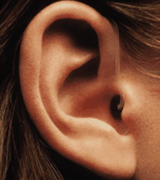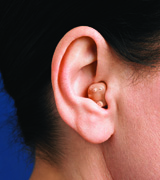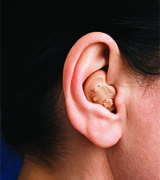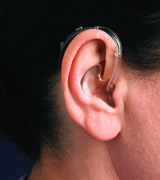Digital Hearing Aids

Digital and Analogue
Digital and Analogue refer to how the hearing aid amplifies and processes sound. Analogue Technology has been surpassed by digital technology. In Very Simple Terms what digital means is that sound is processed by a computer in the heariing aid. How sophisticated the computer is determines how effectively it processes sound and separates out speech from noise. The appearance of the hearing aid may look the same irrespective of the level of technology. In general the more sophisticated the computer, the better the result.
Hearing Aids Comprise:
- A microphone that picks up sound
- An amplifier that processes and makes the sound louder
- a receiver or loudspeaker, that delivers the amplified sound to the ear. All hearing aids use batteries to power the electronic parts. Sound enters through a microphone. It is then processed, amplified and delivered to a receiver. The output from the receiver is sent either directly to your ear canal if you are wearing in-the-ear hearing aids, or receiver-in-the-ear aids, or via tubing if you are wearing behind-the-ear hearing aids.
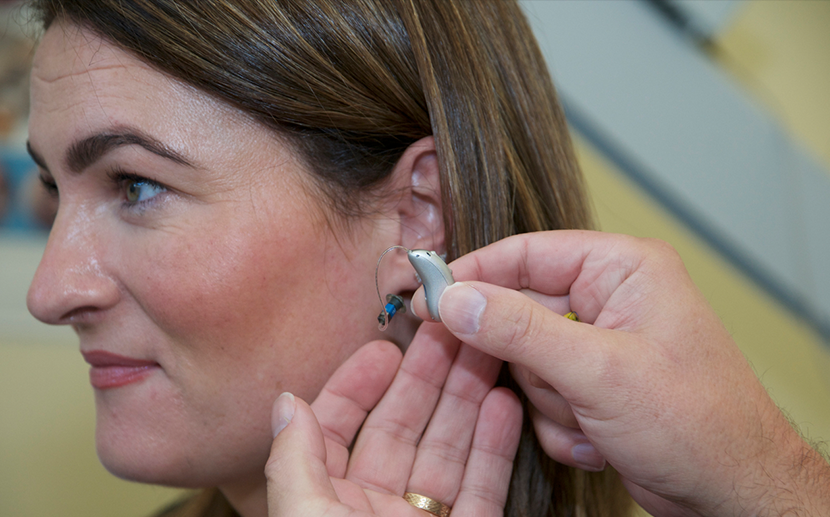
How Digital Aids Work
With digital sound processing, the sound is registered mathematically. Sound is encoded as a series of numbers that measures its pitch and volume at a given instant in time. Processing the sound bit by bit is a much more precise method than previously used. The signal can be manipulated according to your hearing levels and listening needs. Digital sound has minimal distortion and, very importantly, has maximum flexibility, e.g. individual frequencies can be shaped to your hearing loss. Digital signal processing allows manufacturers to create hearing aids with enhanced processing and features thus helping a greater number of people who have a hearing loss than previously.
Are all Digital Hearing Aids The Same?
All digital hearing aids are not the same – They vary from basic to very sophisticated.
Different laboratories or manufacturers can produce better hearing aids for particular types of hearing loss. You cannot tell by looking at the outside, or indeed the inside of a hearing aid, how basic or sophisticated it is. As an independent hearing aid audiology practice, not affiliated to any one laboratory, we fit the most up-to-date technology from all of the major hearing aid laboratories across the world. We do not rebrand hearing aids so that the identity is obscured by giving them another name, thus making comparisons difficult. You are aware at all times of the level of technology that you are being fitted with.
However, even the latest technology relies on professional skill and service if the wearer is to have the greatest benefit and this includes a detailed assessment, programming, fitting, adjusting, subsequent rehabilitation and ongoing maintenance of the hearing aids within their warranty period. Hearing aid fitting is never recommended unless indicated, and we clearly explain what benefit can realistically be expected, given the patient’s level of hearing loss.

Lyric Hearing Aids
A Revolutionary Extended Wear Hearing Aid That Can be Worn 24 Hours A Day
No Battery Changes, Always Working, Truly Hassle Free
Hearing Aid Styles
Hearing aids are available in a variety of styles. Within each of these styles there are a range of different technologies.
On-The-Ear Aids (OTE)
On-The-Ear Aids. This is a discreet, small and lightweight instrument. The ultra-thin transparent soft tubing and small silicone dome snap into the BTE housing as a single unit. An open system ensures that the ear is well ventilated and that you experience a more natural sound, including the sound of your own voice. These are extremely comfortable hearing aids to wear. They are particularly suited to mild to moderate high frequency hearing losses.
Completely In-The-Canal Aids (CIC)
Completely In-the-Canal This is the smallest device available and is cosmetically desirable because it fits deep in the canal and takes advantage of the ear’s natural resonance and shape. Most patients are able to use these hearing aids with the telephone without experiencing “whistle” or feedback. CICs require good manual dexterity, a normal outer ear canal and no medical conditions that would prevent their use. CICs require a precise fit as they are seated deeply within the ear canal.
Receiver-in-The-Canal Aids (RIC)
Receiver-in-The-Canal Aids are miniature Behind-The-Ear Aids that have the speaker or receiver of the hearing aid incorporated in the main body of the hearing aid. The hearing aid is therefore smaller and very discreet. This style can be used for all types and degrees of hearing loss
In-The-Canal Aids (ITC)
In-the-Canal These devices are smaller than ITEs but fit in the outer portion of the ear canal only. ITCs are suitable for patients with an adequate sized ear canal, mild to moderate hearing loss, and without humidity or skin problems of the ear.
In-The-Ear Aids (ITE)
In-the-Ear devices are a custom-made product that fills the bowl of the ear and some portion of the ear canal. A broad range of circuit or chip designs are available that allow these devices to be used in individuals with a mild to severe hearing loss. These devices are easy to manipulate for those with poor vision or manual dexterity problems.
Behind-The-Ear Aids
The Behind-the-Ear (BTE) device consists of an instrument that rests behind the ear attached to a custom-made ear mould. This style may be used for all types and degrees of hearing loss. These devices can be packaged in a mini case depending on the type and level of hearing loss. A BTE device may be required where extra power is needed or where medical conditions such as humidity of the external ear canal prohibit the use of other devices. BTEs are available in several colours for hair and skin tone matching.
Hearing Aid Accessories
There are numerous accessories and assistive listening devices available at the clinic. We are available to advise you if you have specific needs. The following are examples.
Remote Fine-Tuning (Phonak/Resound)
As a Made-For-all solution, hearing aids can connect to Bluetooth enabled devices such as Android or iPhone based smartphone or tablet, allowing handsfree calls through both ears and connection with two Bluetooth devices allows for a seamless listening experience. The hearing aids can also be fine-tuned remotely using smartphone app. With the myPhonak app, you are provided the freedom to contact us without having to visit our practice.
Spend more time enjoying life and less time in appointments!
Remote Controls
Remote controls for those who prefer to be able to hand-control their hearing aids by changing volume and clarity along with accessing different manual programs. These can be useful for those with manual dexterity difficulties. They can also be used for some automatic hearing aids where there are no volume controls or program buttons on the aids.

TV and Multimedia
If you struggle to enjoy using multimedia technology, or you battle with your partner over the TV’s volume level, wireless accessories are the answer. These solutions turn your Phonak hearing aids into a wireless stereo headset – bringing you the clearest personal audio with the minimum of stress.

Phone Use
Many hearing aids have special automatic programs for listening to the phone. Accessories are available for hands free phone listening. These units can stream phone calls directly into hearing aids. Some hearing aids will stream phone calls directly into your hearing aids without any accessories.

Microphones
Roger Pen is a cutting-edge wireless microphone that enables people with hearing loss to hear and understand more speech, in loud noise over distance. It is useful for moderate to severe losses. This fully automated solution, extensively tested and independently validated is proving to be an excellent device. It can be used as a standalone microphone or alongside other Roger Pens or the Roger Clip-On Mic. It also features Bluetooth for mobile phone use and can also be used to listen to TV and multimedia.
Roger Select can be used in in challenging listening situations such as restaurants, meetings at work and school activities to boost your hearing performance – when placed in the centre of a table, it automatically selects the person who is talking and seamlessly switches from one talker to another.

Landline & Cordless Phones
Landline phones are available which will stream directly into your hearing aid.If you are, trying to enjoy a phone conversation, but there’s too much noise and you are overwhelmed. This cordless phone looks like a standard phone, but it’s much more powerful – transmitting sound to both ears simultaneously, reducing noise and maximizing understanding.

Drying Capsules
These are used to remove moisture and humidity from hearing aids and ear moulds which builds up during the day whilst the aids are being worn. One capsule is placed in a drying container into which the hearing aids are placed overnight.

Electric Dryers
These are heatpad-based drying boxes such as ‘the PerfectDry Lux ‘ which have a fan assisted heat drying system with an ultraviolet light (UV) for surface disinfection.

Request an Appointment

Opening Hours
We open every weekday from 9.00 - 5.00. We close for our lunch hour From 1-2. We are closed bank holidays, St Patrick's Day and Good Friday.
Monday - Friday: 9.00 - 5.00
Saturday - Sunday: Closed
Our Address
61 Catherine Street, Limerick
Phone: +353 (0) 061 313 633
Email: info@ferghac.ie
Web: http://www.ferghac.ie

